|
[ Back ] [ Home ] [ Up ] [ Next ]
[ Panama
City Recommendations ]
[
David & Boquete Area Recommendations ]
|
Cursor over pictures to
display caption; click to enlarge then close out of that window. |
PANAMA
Part 1:
(Summer & fall 2008)
| ♦
General |
| ♦
Bocas del Toro
(Aug. '08, Nov. '08) |
| ♦
Inland travel - David, Boquete, Volcán
(Aug. '08)
|
| ♦
Visit to
U.S.A. (Nov.
'08) |
We were surprised to
discover (and feel stupid admitting it!), that Panama actually extends
horizontally west to east - like an "S" laying on its side
- and the Panama Canal runs
north-south (we did know that). Are we the only ones geographically
challenged? - I bet not!

Panama is the
southern-most country in Central America. It is bordered to the west
by Costa Rica and to the east by Colombia; by the Atlantic/Caribbean on
the north and Pacific to the south. At it's narrowest part, the
isthmus is only 30 miles wide.
|
PANAMA |
|
POPULATION: |
3.2 million people; 65% are
mestizo (Spanish-indigenous mix) + sizable Chinese + seven indigenous
tribes; 37% live below poverty line |
|
AREA: |
29,000 sq. mi. - about the size of South Carolina |
|
CAPITAL: |
Panama City |
|
LANGUAGE: |
Spanish |
|
LITERACY RATE: |
93% |
|
OFFICIAL
CURRENCY: |
"Balboa" which is the
U.S. dollar. Coinage is interchangeable between U.S. and the
U.S.-look-alike Panamanian coins |
|
RAINFALL: |
Average per year varies: 4 ft.
Pacific side to 9 ft. Caribbean side |
|
FAMOUS FOR: |
Panama Canal |
BRIEF HISTORY:
|
1878 |
French attempt to build the
Panama Canal; later abandon it due to fatal malaria, yellow fever and
bankruptcy |
|
1903 |
Panama declares independence
from Colombia; U.S. supports this move |
|
1914 |
U.S. completes Panama Canal
|
|
1921 |
Colombia finally recognizes
Panama's independence - after U.S. pays Colombia US$25 million in
"compensation" |
|
1989 |
U.S. invades Panama and
extradites Manuel Noriega on conspiracy and drug trafficking
charges |
|
2000 |
U.S. turns control of the
Panama Canal over to Panama |
|
2006 |
Panamanians vote to expand the
Canal and build 3rd set of locks |
|
2015 |
Expected completion date of
Panama Canal expansion project |
|
|
|
|
|

|
LEMONS !
Believe it or not, lemons are not found
in the Caribbean. So far, the only places we've been able to buy
lemons are Bonaire and here in Bocas del Toro. Limes are usually
plentiful and used in place of lemons. |
|
BOCAS DEL TORO, PANAMA
is located in the west on the Caribbean side (see map above). We
arrived June 18, 2008 and are currently in the Bocas Marina, a nice 100-boat
marina with floating docks, where we will leave ARGO when we visit the USA this fall.
Bocas del Toro is a large area with lots of
 islands,
coves and small settlements. It is a cruiser community with a couple
of marinas and anchorages. This area is also known for its surfing,
and there are several cruisers here for just that reason. The main
town of Bocas town is a vacation destination with a range
from backpacker hostels to nice hotels; has decent, well, basic at best, shopping and services;
and lots of restaurants/bars. It is a big hangout for backpackers and
supposedly really rocks at night - but we wouldn't know 'cuz us old folk
cruisers don't go out in the dinghy at night here for water safety reasons! islands,
coves and small settlements. It is a cruiser community with a couple
of marinas and anchorages. This area is also known for its surfing,
and there are several cruisers here for just that reason. The main
town of Bocas town is a vacation destination with a range
from backpacker hostels to nice hotels; has decent, well, basic at best, shopping and services;
and lots of restaurants/bars. It is a big hangout for backpackers and
supposedly really rocks at night - but we wouldn't know 'cuz us old folk
cruisers don't go out in the dinghy at night here for water safety reasons!
| AGAIN . . .
NOBODY KNOWS
Compared to the rest of Central
America (Costa Rica excepted) we think of Panama as being more civilized
and organized. Maybe so in some respects, but with respect to
their immigration laws, nobody really knows what the law is.
Seriously. Their immigration law is in
a constant state of flux.
We cleared in mid-June, 36 hours after a
friend of ours, and were told that different rules now applied to us.
The official explained that they ". . . had a meeting yesterday and that the
rules will be changing on July 1. Even though it's not July yet, my
boss told me to start using the new procedures to get people used to the new
rules." And so we were subjected to the new, less favorable rules.
 Now we have to go
into Changuinola on the mainland (via hour water taxi, then 20 minute taxi)
every 30 days (old new rules) to renew our immigration. The seemingly
knowledgeable official there admits that the rules/law literally change on a
daily basis, so she tells everyone to call her before coming to see what the
latest rules are and how it affects them! And as with most Caribbean
countries, the bureaucratic paperwork-push-pull is astounding. Now we have to go
into Changuinola on the mainland (via hour water taxi, then 20 minute taxi)
every 30 days (old new rules) to renew our immigration. The seemingly
knowledgeable official there admits that the rules/law literally change on a
daily basis, so she tells everyone to call her before coming to see what the
latest rules are and how it affects them! And as with most Caribbean
countries, the bureaucratic paperwork-push-pull is astounding.
|
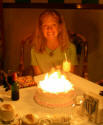 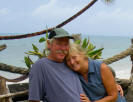 Shortly
after we arrived in Bocas del Toro, our Texas cruising friends Mary Ellen &
Randy, s/v Wanda Jeane, who we sailed south with from Honduras, took us on an
inland trip into western Panama, where they now have their residence.
What better way is there to see an area up close and personal! Shortly
after we arrived in Bocas del Toro, our Texas cruising friends Mary Ellen &
Randy, s/v Wanda Jeane, who we sailed south with from Honduras, took us on an
inland trip into western Panama, where they now have their residence.
What better way is there to see an area up close and personal!
WESTERN INLAND TRAVEL
 Traveling
by rental van, we visited
David (pronounced dah-veed), the biggest city in the region and due south of
Bocas del Toro. Although not very far as the crow flies, it takes
about 4 hours as we have to cross over the Continental Divide. David
is not very far from the Pacific and almost at sea level. Shopping is
quite good (great grocery/deli stores, Target/Wal-Mart/Home Depot type stores, and you
wouldn't believe all the electronics stores!), and cruisers come here (or
Panama City) for their medical needs. (P.S. We did our routine
physical exams in Nov. '08 and were very pleased with the medical attention
we received.) Traveling
by rental van, we visited
David (pronounced dah-veed), the biggest city in the region and due south of
Bocas del Toro. Although not very far as the crow flies, it takes
about 4 hours as we have to cross over the Continental Divide. David
is not very far from the Pacific and almost at sea level. Shopping is
quite good (great grocery/deli stores, Target/Wal-Mart/Home Depot type stores, and you
wouldn't believe all the electronics stores!), and cruisers come here (or
Panama City) for their medical needs. (P.S. We did our routine
physical exams in Nov. '08 and were very pleased with the medical attention
we received.)
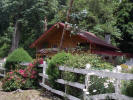  In
the middle of this mountainous region is Volcán
Barú
- the highest point in Panama and the country's only volcano (inactive).
We first travel to the "other" (west) side of the volcano, to a string of
small towns such as Volcán
and
Cerro Punta. A In
the middle of this mountainous region is Volcán
Barú
- the highest point in Panama and the country's only volcano (inactive).
We first travel to the "other" (west) side of the volcano, to a string of
small towns such as Volcán
and
Cerro Punta. A gricultural
farming is a mainstay here, amazingly done on the steep mountain
slopes; horse, cattle and trout farms as well. Our first impression was of European alpine country, with
wooden A-frame houses, colorful window flower boxes and yards filled with
vibrant color. The air is cool and crisp, as clouds hang off in the
distance suspended between mountain tops. Very refreshing and
invigorating. Our rooms were alongside a rushing stream that provided
a perfect backdrop for sleeping. gricultural
farming is a mainstay here, amazingly done on the steep mountain
slopes; horse, cattle and trout farms as well. Our first impression was of European alpine country, with
wooden A-frame houses, colorful window flower boxes and yards filled with
vibrant color. The air is cool and crisp, as clouds hang off in the
distance suspended between mountain tops. Very refreshing and
invigorating. Our rooms were alongside a rushing stream that provided
a perfect backdrop for sleeping.
|
FINCA
DRACULA ORCHID SANCTUARY |
|
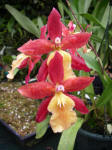

In Cerro Punta,
we toured Finca Dracula, home to one of the world's largest and most complete
collections of rare American orchid species. They have over 2,200
different orchid species. WOW, we never knew
there were so many different looking orchids, and in every color
imaginable.
|
Above, one of the
many orchid houses. This one is for high humidity, with water
moats. |
|
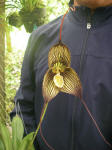
Dracula vampira |
The finca
(plantation) takes it's name from the orchid genus Dracula, so
named because of the two fang-like, downward hanging, petals. Some
of them look just like a monkey's face. |

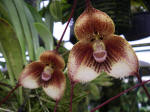 |
 |

This one is covered in bristling
hairs |

In nature, reproduction is scanty
and maturation slow. Here in their labs, they are able to mass
produce orchid plants in vitro and have produced more than a million.

 |

Teeny tiny orchids |
In their labs,
they are able to make many novelty orchid hybrids using their vast and
extensive collection as stud plants. They have over 300 species
made from their own hybrids.
 |

We witnessed this orchid that only
blooms for 8 hours once a year - and we were there to see it (or was that a
plastic flower?). |
|
Orchids have
different scents to attract bees, hummingbirds and other birds, bats,
etc. We smelled orchids that had scents of vanilla, eucalyptus,
bananas, cinnamon and so on. At the Finca, they pollinate the
flowers by hand, seed pods develop and several months later they take
the seed pods off and plant them separately. |
       |
       |
|
www.fincadracula.com |
  We
then had to backtrack to David and around to the east side of Volcán Barú
- there is a challenging hiking path that skirts the volcano from one side
to the other. Around
on the other side is the town of
Boquete, which has grown by leaps and bounds over the
past 3 or 4 years, mostly by gringos moving into the area. (This
Chiriqui province's investments grew by 40% from 2006 to 2007.) Although
not as big as David, it has decent shopping and even better restaurants - so
much that Davidians make the 45 minute trip in for dinner. Boquete is
situated in the valley, surrounded by mountains covered in coffee
plantations - from which you can see the Pacific Ocean on some days. We
then had to backtrack to David and around to the east side of Volcán Barú
- there is a challenging hiking path that skirts the volcano from one side
to the other. Around
on the other side is the town of
Boquete, which has grown by leaps and bounds over the
past 3 or 4 years, mostly by gringos moving into the area. (This
Chiriqui province's investments grew by 40% from 2006 to 2007.) Although
not as big as David, it has decent shopping and even better restaurants - so
much that Davidians make the 45 minute trip in for dinner. Boquete is
situated in the valley, surrounded by mountains covered in coffee
plantations - from which you can see the Pacific Ocean on some days.
  Mary
Ellen and Randy's property is situated on a ridge, their house surrounded by
lush coffee plants/plantations, and with an up-close and personal view of
the volcano on one side, and mountains and undisturbed valley on the other.
They have planted scores of citrus and avocado trees, some of them they have grafted,
and loads of flowering trees, bushes and plants around the house. Not
only beautiful, but unbelievably peaceful with nothing else around except
the sound of nature! Mary
Ellen and Randy's property is situated on a ridge, their house surrounded by
lush coffee plants/plantations, and with an up-close and personal view of
the volcano on one side, and mountains and undisturbed valley on the other.
They have planted scores of citrus and avocado trees, some of them they have grafted,
and loads of flowering trees, bushes and plants around the house. Not
only beautiful, but unbelievably peaceful with nothing else around except
the sound of nature!
In Boquete, we were
lucky enough to meet a lot of Mary Ellen and Randy's friends, and got to see their
new homes - all of which are different and all with wonderful, spectacular views. Those who
live on small coffee parcels typically hire cheap labor to maintain the crop and
pick the coffee beans. In some cases, a local commercial coffee grower will provide
this service in exchange for the coffee bean production, less whatever the
property owner wants to keep for personal consumption.
|
EXPAT HAVEN
Panama wants to
attract residents and businesses and is taking steps to simplify (but
not necessarily to expedite) the process. One way is with the
pensionada visa - you only have to prove good health, no criminal
record and a monthly income of $500, or buy a home for at least
$200,000. The pensionada entitles you to bring in household
goods and import a new car without paying duty, have a 20-year tax
holiday and enjoy discounts of 15% to 50% on hotels, restaurants, air
and other travel, movies and many professional services. We know
quite a few cruisers who have applied/received their pensionadas.
The downside is that it takes at least 9 months and can be a VERY
frustrating experience - as we've witnessed some of what Mary Ellen and
Randy have gone through, even when an attorney is employed! Again,
nobody really knows and there's a lot of finger-pointing going on
between those "in the know". |
 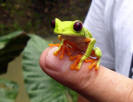
There's more to come on Bocas del Toro
. . . and Panama . . .
and the Panama Canal
. . .
- - -
- -
We are flying back to the USA for a
visit in October
and November, as we have not been back in 2 1/2 years. We have not
explored by boat outside Bocas del Toro, so when we return, we plan on
heading out . . . but where we're going, nobody
knows . . .
- - -
- -
|
|
VISIT
TO U.S.A.
   We
flew on a small prop plane from Bocas del Toro to Panama City (otherwise
it's a long, 12-hour bus ride over the mountains). A
direct flight got us back into Houston in 4 hours, flying directly over Isla
Providencia (offshore Nicaragua) and other isolated reefs and cays that gave us
an awesome birds-eye view of some of the places we had just come from months
earlier. We
flew on a small prop plane from Bocas del Toro to Panama City (otherwise
it's a long, 12-hour bus ride over the mountains). A
direct flight got us back into Houston in 4 hours, flying directly over Isla
Providencia (offshore Nicaragua) and other isolated reefs and cays that gave us
an awesome birds-eye view of some of the places we had just come from months
earlier.
Our 2 months in the
USA were spent visiting family and friends in Houston (where our condo is),
Dallas, Kansas City, Pittsburgh and St. Louis. It was also time to
renew our U.S. Coast Guard (Merchant Marine) licenses. During our
stay, hurricane Ike blasted through Houston (and Galveston) - our only
damage at our condo was several large fallen trees but no structural damage.
Surprisingly, most of our friends faired quite well with their houses and
boats - we consider them very lucky as so many people lost everything.
|
U.S.A. VISIT (Fall '08) |
|
DALLAS:
Debbie's Dad, Chuck (with Nathan) |
 |
Had a great visit going through
lots of photos - some very old to current. Had us guessing on
who some of the people were in them! |
| |
|
KANSAS CITY:
Steve's daughter Jill and
husband Scott; granddaughters Abby, 8, and Ashton, 5. |
 |
 |
Both girls are big soccer
players; Abby also plays softball and basketball |
 |
| |
|
ST. LOUIS: |
 |
Lots of food, drink, activities
and games for all ages |
 |
Jackie, Abby & Ashton
representing our "M&M" (Mary & Martin) family |
|
Steve's Mom's side of the family
had a big family reunion (97 out of 240 people attended) |
 |
Surprise birthday party for
Steve! |
|
| |
|
PITTSBURGH:
Steve's daughter, Jana |
 |
This was our
first trip to Pittsburgh (pop. 300,000; 1.3 million in greater
metropolitan area) and we were very impressed with the city.
The downtown sits on a point where the Allegheny and Monongahela
rivers join to form the Ohio River. Long gone are the dirty,
pollution-spewing steel mills and coal mines, and black buildings.
Instead, we found a clean, pleasant, health- and philanthropic-
minded city. The fact that there are about 30 colleges and
universities here, including Carnegie-Mellon, keeps the city young,
thriving and full of culture - a great place for Jana to live and
work. |
    
Click picture to see enlarged
panoramic view
. . . and count the bridges! |
|
As you can
see from the panoramic picture, Pittsburgh is the city of bridges:
Stats vary, but suffice it to say that there are 15 major
bridges in downtown Pittsburgh alone; roughly 700 bridges inside the
city limits and 2,000 in Allegheny County. This gives the city the
distinction of having the most bridges in the world, just surpassing
the previous leader, Venice, Italy. Other city highlights
include: Lots of pioneer-setting medical endeavors (Jonas Salk
invented the polio vaccine); employer-provided health care
originated here; lots of great micro-brewed beers; the largest
population of veterans - and a huge Veterans Affair (Administration)
operation (where Jana works); home to Heinz ketchup; standard deli
fare includes French fries and coleslaw loaded into your
sandwich; and devout Pittsburgh Steeler followers. One more tidbit: The "h" was dropped in
"Pittsburg" in 1891, but was restored 20 years later. |
| |
|
HOUSTON:
Aside from hurricane Ike, we really enjoyed our visit in Houston
catching up with family, friends, our sailing club, work chums, and
several cruisers that we'd met over the past couple of years in the
Western Caribbean.
One of the
things that struck us most, besides the usual sticker-shock, was the
amount of "excess" to which people have become so accustomed.
We couldn't believe the number of SUVs that are on the road - pretty
much 9 out of every 10 vehicles we saw in "affluent" neighborhoods
was one of these monsters. And the "excess" number of
selections available to consumers is overwhelming (and not
necessary): For example, I noticed that Tropicana orange juice
(carton) now comes in about 20 variations: no pulp, some pulp,
lots of pulp, with calcium, with calcium + D, lots of pulp with
calcium + D, with vitamin C, with omega 3, low acid, light 'n
healthy with pulp, light 'n healthy with calcium, for kids (!), with
antioxidants, without antioxidants, etc. . . Geez,
com' on . . . !
Another thing
horribly blatant, and I'm sure not at all surprising to you, is the
super-fast-paced daily lifestyle. It shows us just how much we
have been able to slow down and enjoy things - which we think also
has great health benefits! |
| |
|
GOT A LOT OF
BAGGAGE !
As is
typical with cruisers returning from the USA, one is always
grossly laden with a lot of excess baggage*, resulting
nowadays in stiff fees from the airlines. Coming back
we had 4 large bags, 2 backpacks and 2 briefcases, weighing
a total of 260 pounds. The 4 large bags weighing 188
pounds had to be checked. Flying between Panama City
and Bocas, Aeroperlas allows each person one checked bag, 27
pounds max, with extra weight charged at
70¢/pound, or $130 for us! BUT, by going to the airport the
day before, we checked our 4 bags as cargo, and paid
only 30¢/pound, saving $75! The day we traveled we
were then able to check our backpacks and considerably
lighten on onboard load. When we reached the Bocas
airport, our "cargo" was securely waiting for us.
Think we did too much shopping in the USA? A better
question might be where will all this stuff go on ARGO?!
We
did the same thing when we flew to Panama City in route to
Houston. But we only had 95 pounds (to take back and
leave at our condo) to send as cargo then.
On the
Continental International flight from Houston to Panama City we were allowed
to check one bag up to 50 pounds each at no charge and carry on our backpacks
and briefcases. Extra bags were charged a flat $25 each, so a total of $50
for us.
*
Excess baggage for us includes new and repaired boat equipment and boat
parts and supplies (some of which can be very heavy and/or
bulky), and dearly beloved items (like specialty toiletries,
drug store items and marine cleaning supplies) that cannot
be found down here. And there's always a few things to
bring back for other cruisers, as they have done for us,
too.
|
| |
|
|
And after our return to Bocas del Toro:
|
40 DAYS, 40 NIGHTS + A QUIVER TO BOOT
 A
little geographical background. Bocas del Toro is a group of islands
off Panama's north mainland, protected by reefs. Supplies, fuel and
people come from Panama City and David across the mountains to the small
coastal port of Almirante. From Almirante, they are transported by
ferry or water taxi to Bocas del Toro. Otherwise, this community is
pretty isolated. A
little geographical background. Bocas del Toro is a group of islands
off Panama's north mainland, protected by reefs. Supplies, fuel and
people come from Panama City and David across the mountains to the small
coastal port of Almirante. From Almirante, they are transported by
ferry or water taxi to Bocas del Toro. Otherwise, this community is
pretty isolated.
Two weeks ago
during the night we were hit with a 6.2 earthquake, the epicenter 85
miles from us and only 35 miles from where we had been in David 2 days
earlier. Only minor damage in David. At about the same time,
it started raining here, torrential at times, practically non-stop, for
10 days. All the weather stirred up the offshore seas with 12 ft.
waves. And if that wasn't enough, at the same time extraordinarily
high tides were occurring (usually minimal here, tide tables showed a
1.5 ft. high tide - huge for here) for over a week.
 The
result of all this was a lot of mudslides and washed out bridges in the
mountains, cutting off the transportation
supply route to our area, and
disorienting cell/phone towers. Lower lying land including
Almirante and Bocas, were flooded: Fish were literally swimming through
our marina's restaurant/bar; 4 - 6 ft. breakers were coming over
the sea wall in town and flooding the streets, businesses and homes.
(The fire dept. was on the VHF inquiring when high tide was.)
Boats here at the marina that are not on a floating dock (ARGO's on a
floating dock) literally slipped their dock lines off the pilings. The
result of all this was a lot of mudslides and washed out bridges in the
mountains, cutting off the transportation
supply route to our area, and
disorienting cell/phone towers. Lower lying land including
Almirante and Bocas, were flooded: Fish were literally swimming through
our marina's restaurant/bar; 4 - 6 ft. breakers were coming over
the sea wall in town and flooding the streets, businesses and homes.
(The fire dept. was on the VHF inquiring when high tide was.)
Boats here at the marina that are not on a floating dock (ARGO's on a
floating dock) literally slipped their dock lines off the pilings.
The town and
marina became cut off from all supplies, diesel was running out (diesel
fuels the town's generator which supplies the marina's electricity) and
gasoline has run out (for water taxis and our dinghy outboards).
Water taxi service
at this time is curtailed so nobody is coming in or going out, including
the tourist trade (not that there would be any
food for them). A diesel barge was being sent from Colon but it
was being detained because of the 12 ft. seas. The word is that
gasoline is coming "tomorrow". All flights (small planes) have
been cancelled for a week.
Were we
personally affected? Fortunately, we float and didn't feel the
earthquake, either. Our cell and internet service was interrupted
for a few days. Fresh produce was lacking, but we've got plenty of
food on board. Because of the high tide running through the
restaurant, our marina's Thanksgiving feast was postponed a few hours
(some wanted to postpone to Saturday or the next week!) - and we had a
truly lovely evening with over a hundred people and lots of outstanding
pot-luck dishes. When we heard about the fuel shortages we quickly
filled our tanks (from the marina's supply) and topped off our gasoline.
One little problem
for us is that we are now past due on renewing our immigration papers, which
requires us to travel to the mainland town of Changuinola by water taxi and
then taxi or bus. The worthless immigration officer here in Bocas -
who has no authority whatsoever - tried to convince us we must go to
the mainland last week - right, no water taxi, roads closed, bridges washed
out, immigration office a disaster and may be closed for weeks. Port
Captain here says don't worry about it. Bet it'll be fun 'xplaining it
to the officials when the time comes! Conflicting reports all around
. . . see, nobody knows . . .
Walking through
Bocas town today, the streets that are usually filled with lots of
backpackers, divers, surfers and other tourists and locals peddling
their services and wares, was empty except for the locals milling
around. For the past several days, U.S. Military Black Hawk and
Chinook helicopters have been coming in with relief supplies. We passed by the
nearby airstrip today just as 2 U.S. Army helicopters (from a ship stationed off Honduras, we
think) landed and unloaded hundreds of bags of relief supplies, each
helicopter was in and out in less than 10 minutes. This went on
literally non-stop all day long.
November is the
end of rainy season here in Panama, and from what people say, it usually
ends with a bang, or should I say, a whopping whosh and so it did.
Dec. 1, 2008
|
|
|
For our
update on Panama City and our boat tour of the Panama Canal,
continue
. . . |
[ Back ] [ Home ] [ Up ] [ Next ]
[ Panama
City Recommendations ]
[
David & Boquete Area Recommendations ]
[ Top of page ]
|
![]()